MARIANI’S
Virtual
Gourmet
March
29, 2015
NEWSLETTER

Welcome Back, Mad Men!
❖❖❖
IN THIS ISSUE
IS COOKING REALLY AN ART?
By John Mariani
NEW YORK CORNER
TBAR
By John Mariani
NOTES FROM THE WINE CELLAR
SPANISH WINES
By Brian Freedman
❖❖❖
IS COOKING REALLY AN ART?
By John Mariani
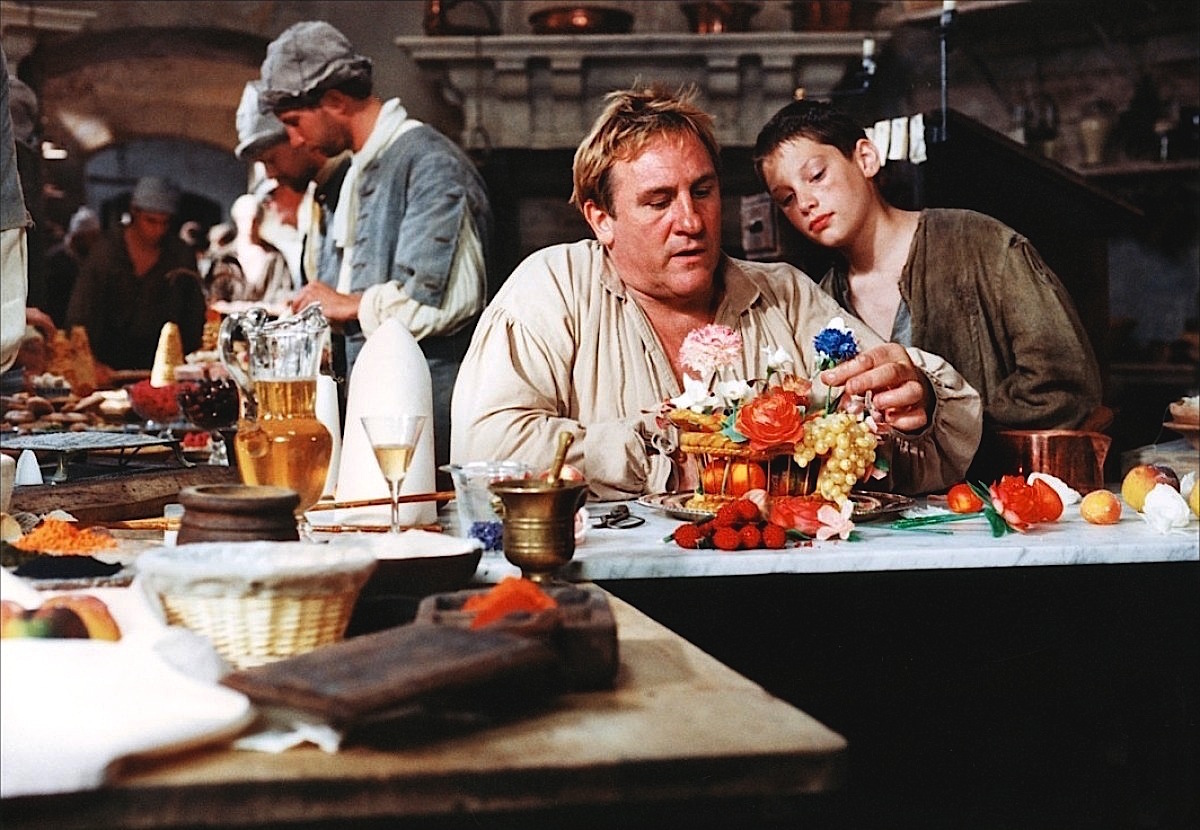
Gérard Depardieu in "Vatel" (2000)
The package landed
with a considerable thud on my desk, a two-volume,
18.2-pound, 932-page production entitled Notes from a
Kitchen: A Journey Inside Culinary Obsession
by photographer Jeff Scott and chef Blake Beshore. 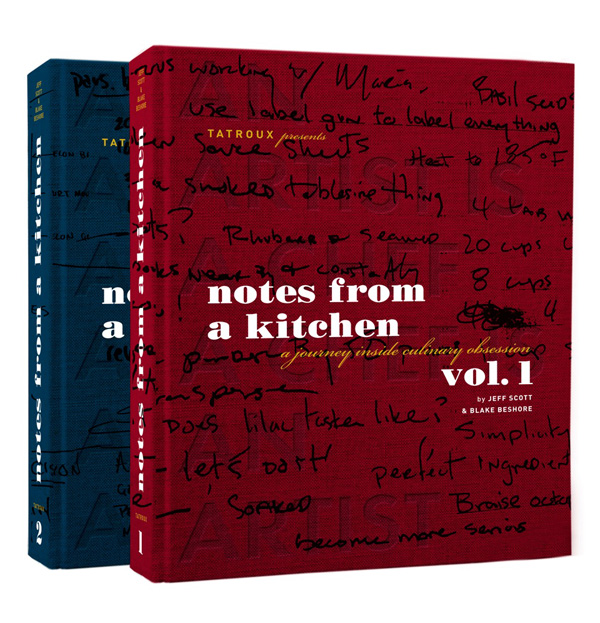 It is a
collection of photos, with little text, showing the
work of cooks on the line, focusing on 10 American
chefs--mostly Sean Brock, along with George
Mendes, Johnny Iuzzini, Emma Hearst, Zak Pelaccio,
Michael Laiskonis, Jason Neroni, Matt Gaudet, Joel
Harrington and Neal Fraser.
It is a
collection of photos, with little text, showing the
work of cooks on the line, focusing on 10 American
chefs--mostly Sean Brock, along with George
Mendes, Johnny Iuzzini, Emma Hearst, Zak Pelaccio,
Michael Laiskonis, Jason Neroni, Matt Gaudet, Joel
Harrington and Neal Fraser.
There are shots of order tickets,
menu notes, 23 photos of one chef working out with a
punching bag, and nine pages of the inside of a
flour mill. But mostly there are hundreds of photos
of cooks’ hands putting the final touches on a
dish--a periwinkle on tapioca, a pin dot
of sauce on octopus, a blow torch to cactus pads.
There are no recipes.
It is an odd production, to be
sure, but you can hardly fault the exuberance of
Scott and Beshore in trying to view “chefs as
artists who alter our emotional state by
psychologically affecting our sense memories,”
citing Sean Brock on the reaction of an unidentified
food writer who broke down eating his food [italics
his]: “This
food writer ate a dish and cried. She came back to
the kitchen in tears. It’s crazy when food affects
people like that. They get into it so much that
it’s too much for them, it’s emotional for them.
When grown people start crying that’s insane.” True.
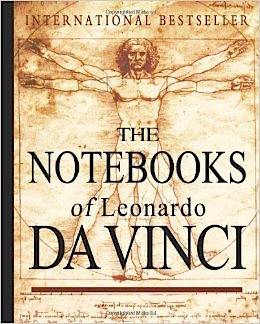 The book is an extravagance
of both scale and scope, especially since a
two-volume Notebooks
of Leonardo da Vinci weighs in at just 294
pages and 1.6 pounds.
More important, Notes from a
Kitchen’s publication poses the question, is
cooking an art?
The book is an extravagance
of both scale and scope, especially since a
two-volume Notebooks
of Leonardo da Vinci weighs in at just 294
pages and 1.6 pounds.
More important, Notes from a
Kitchen’s publication poses the question, is
cooking an art?
The new Fifth Edition of The American
Heritage Dictionary of the English Language gives
a reasonably cogent definition of art: “The
conscious use of the imagination in the production
of objects to be contemplated or appreciated as
beautiful, as in the arrangement of forms, sounds,
or words.” It also
gives a fourth definition of an art as
“A skill that is attained by study, practice, or
observation [e.g.]: the art of
negotiation." The fifth definition is “Artful
contrivance; cunning.”
When it comes to cooking, I’d be happy to
apply these last two, but not the first, but I might
also argue that art, as noted in the first
definition, surely doesn’t have to be “beautiful.”
There is ugly art (Hieronymus Bosch, right) and
troubling art
(Goya’s
“Disasters of War”) and art that is
deliberately in your face (Kerouac’s On the Road),
disorienting (Kubrick’s “2001: A Space Odyssey”),
even repulsive (the Sex Pistols’ “God Save the
Queen”). 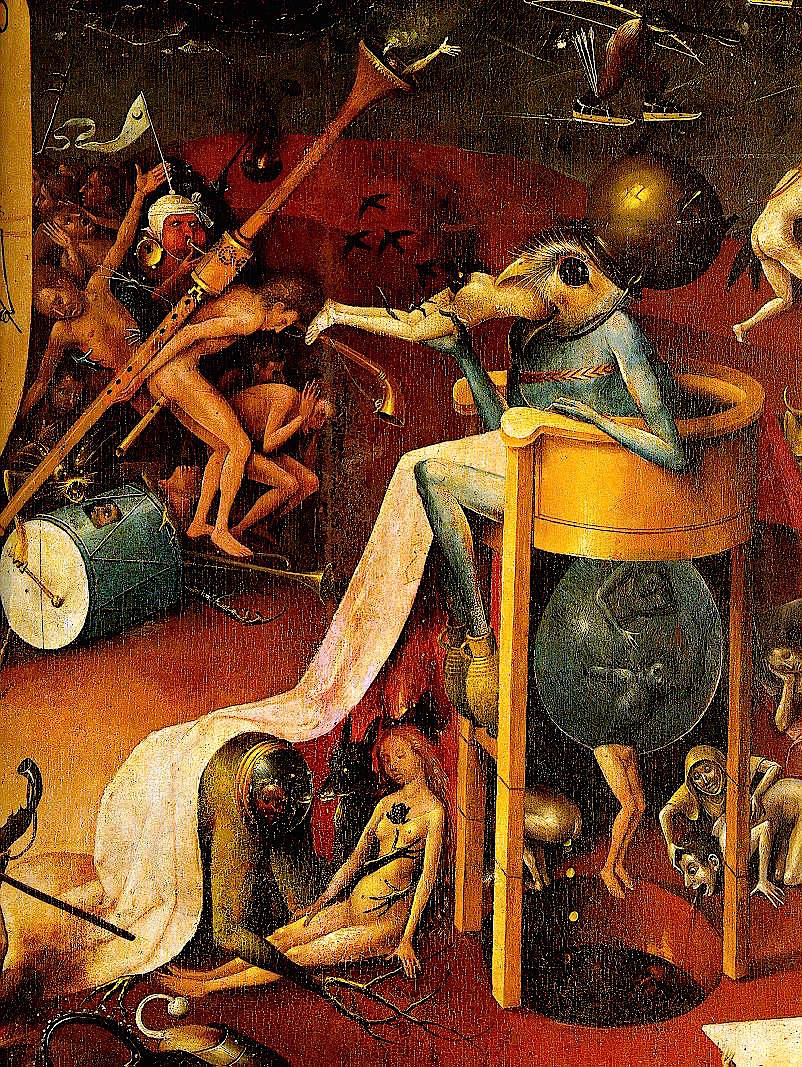 Cooking, on the other hand,
should be none of these things except, perhaps,
beautiful to look at on the plate and delicious on
the tongue.
Cooking, on the other hand,
should be none of these things except, perhaps,
beautiful to look at on the plate and delicious on
the tongue.
Creative
cooking might well enlighten a person to new
possibilities or ways of thinking about a pea shoot,
and that is a good thing in a world of fast, frozen,
chemically enhanced foods. Cooking can be
provocative, but only a fool makes food that is
deliberately distasteful or that seeks to outrage
people. Cooking is actually much closer to science
than art, as the six-volume, 2,438-page, 48-pound
book called Modernist
Cuisine shows at enormous cost in recipes that
come more from a chem lab than an art studio. As any
pastry chef will tell you, there is no less
chemistry involved in the making of a croissant than
in the glazing of fine china or making pewter.
Cooking,
like the art of negotiation, the art of politics,
even the art of war, is clearly a skill attained by
study, practice and observation, that is, a craft. That is
what the great 19th
century master chef Carème (below), who codified French haute
cuisine, meant when he titled his five-volume
encyclopedia  L’Art de la Cuisine Française. Of
course, imagination and creativity go into cooking,
often at a very high level, at which point it is
called “haute” cuisine. But there is nothing that
rises to the level of true art in a craft whose very
existence depends on the constant replication of a
dish, night after night, week after week. The
replication of stenciled friezes, even if originally
designed by Raphael, does not constitute art, and
I’m sure Andy Warhol was mumbling all the way to the
bank when his work went from replicating Brillo
boxes to having assistants replicate his own work.
L’Art de la Cuisine Française. Of
course, imagination and creativity go into cooking,
often at a very high level, at which point it is
called “haute” cuisine. But there is nothing that
rises to the level of true art in a craft whose very
existence depends on the constant replication of a
dish, night after night, week after week. The
replication of stenciled friezes, even if originally
designed by Raphael, does not constitute art, and
I’m sure Andy Warhol was mumbling all the way to the
bank when his work went from replicating Brillo
boxes to having assistants replicate his own work.
“If chefs ate their own food,” said Paul
Bocuse, “we’d have a better cuisine,” and the first
duty of any cook is to make delicious food, to make
his guests happy, sometimes surprising them with a
novel idea, sometimes keeping them guessing with a
bit of trompe l’oeuil. The French have always
recognized this distinction, emphasizing again and
again simplicity in cooking, just as did Leonardo da
Vinci--who designed both a convection rotisserie
oven and a cooling distillation machine--when he
said of art and craft, “Simplicity is the ultimate
sophistication,” whether in a painting, battlements
or the kitchen. When a chef goes to deliberate
extremes to create dazzle on the plate, he or she is
violating the cardinal principle French gastronome
Curnonsky insisted on: “Cuisine is when things taste
like themselves.”
In cooking, form follows function, not
vice-versa, in the same way the designer of a
beautiful airplane has, by necessity, to make sure
the wings stay on.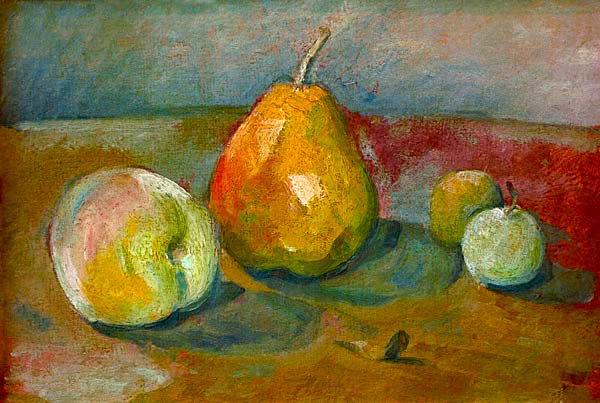
Line cooks are obsessive about
their work simply to keep up when 25 orders come in
at once. They try very hard to make the food as good
as they have been taught, but too many chefs with
their heads in the stars obsess more on their own
image, causing fawning media to toss around terms
like “artist” and “genius” as if the chef were
Cézanne painting apples and pears. Ever
humble Cézanne (right),
whose favorite food was potatoes cooked in oil,
insisted that,
"When I judge art, I take my painting
and put it next to a God-made object like a tree or
flower. If it clashes, it is not art."
Surely, using tweezers to place micro-greens just so on top
of layers of foie gras and puff pastry does not
constitute art at any level. There
is a craft to making good pizza or a
juicy roast chicken but it is not an art form. Extravagance in
cuisine, whether it’s the mounting of a 200-course
dinner at Versailles, or a chicken stuffed into a
duck stuffed into a turkey, is mere cunning
artifice, to be applauded for what it is--fun,
enticing, beautiful, but it isn’t art.
❖❖❖
By John Mariani
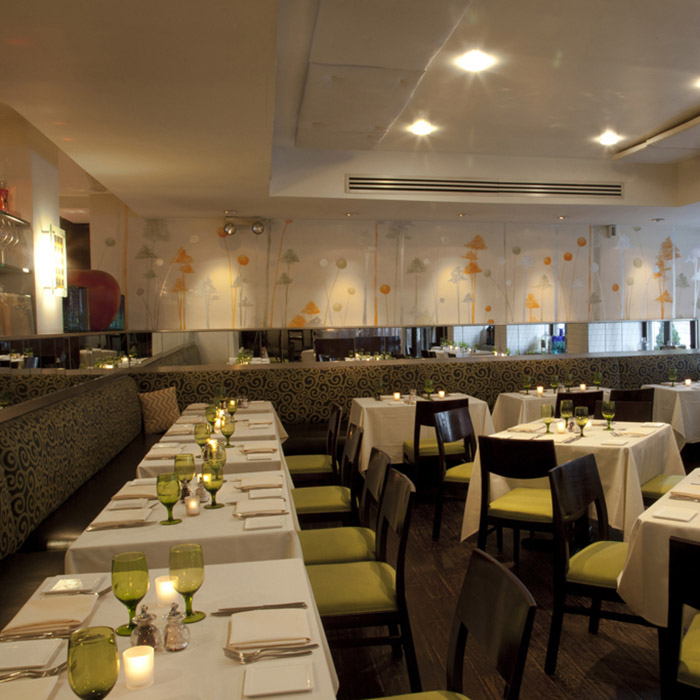 TBAR
TBAR1278 3RD Avenue (near 73rd Street)
212-772-0404
http://www.tbarnyc.com
As the
Willie Nelson song goes, “Ain’t it funny how time
slips away?” I’ve
known restaurateur Tony Fortuna for many years as
one of the true gentlemen of the profession, so it
was with surprise that upon hearing he owned TBar I
realized it’s been seven years since I’d see him.
TBar has actually been a fixture
on the Upper East Side (it used to be The Lenox
Room) and is easily one of the handsomest of
restaurants in a neighborhood where the creaky old
J.G. Melon is the only other stand-out among
storefront ethnic eateries. Melon, of course, is a
hang-out for burgers and chili, whereas TBar is a
full-fledged restaurant, also with burgers on the
menu, with an equal number of steaks and chops,
apps, salads, pastas, and a good pizza margherita
($19) for the table to share.
Executive chef Ben Zwicker has spent time in
notable kitchens that include Four Seasons, Aureole,
and Petrossian, and his aim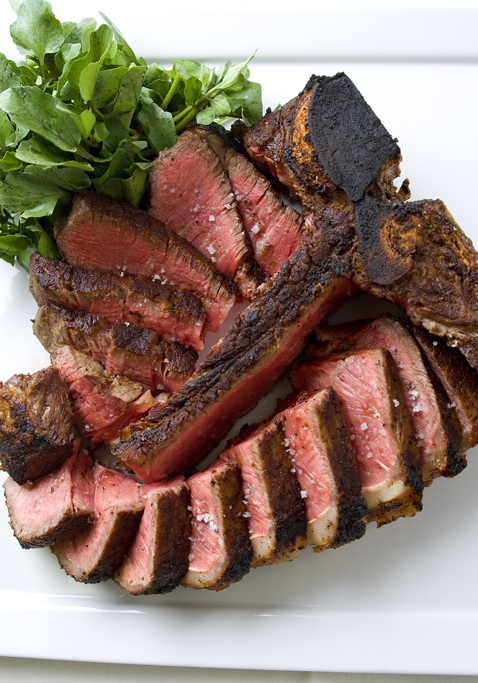 at TBar is
to provide consistency to a clientele that assume
their favorite items on the menu to be the same
every time they order them.
at TBar is
to provide consistency to a clientele that assume
their favorite items on the menu to be the same
every time they order them.
The premises are bright with
primary colors and soft lighting, emanating from
white tablecloths and from overhead lights that
bounce off a delightfully whimsical mural.
Comfortable banquets and chairs and votive candles
on the tables lend the dining room a civilized
ambiance without a whit of pretension, and newcomers
will feel welcomed warmly at the front, where there
is an active bar stocked with all the best labels of
booze.
Our party of four began by
sharing one of those crisp, delicious pizzas ($19)
as well as nicely peppery “angel” chicken wings with
a tangy-sweet tamarind glaze ($18). Guacamole
with vegetable crudités ($27) was good, though it
could have used a bit more spiking.
In a city now wall-to-wall with
seared octopus dishes, the variation at TBar, with
potatoes, celery and olives ($18), is a real
standout, just lightly seared and smoky, very tender
and mild in flavor.
Yellowfin tartare with soy, ginger and sesame
seeds ($22) was cool and finely seasoned to bring
out the freshness of the coarsely chopped fish.
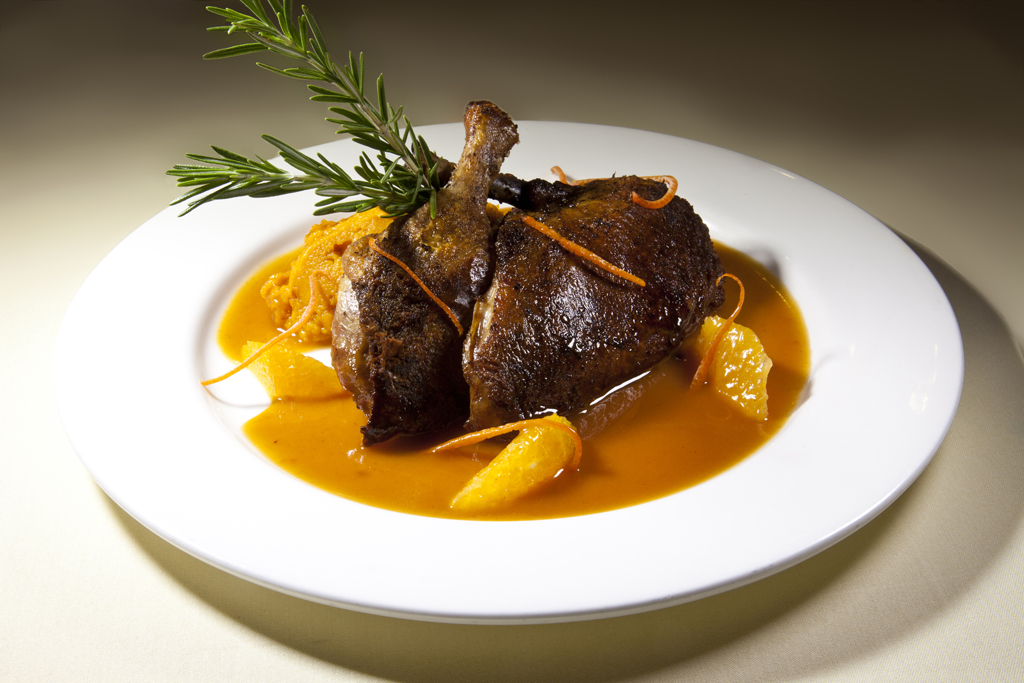 For
our entrees we went with an excellent 40-ounce Black
Angus porterhouse (right)
for two ($105)--though two people will undoubtedly
take some home--with its complimentary choice of
Béarnaise, steak or poivre
sauce, and a 24-ounce bone-in ribeye ($56) that
could just as easily feed two. A “crispy Long
Island Duck” (left)
with sweet potato and orange glaze ($38) hearkened
back to the days when this dish was on every French
and continental menu in NYC but now is rarely to be
found on any. TBar’s, though not as crispy as I'd
hoped, reminded me how wonderful roast duck with
orange sauce can be as an alternative to the endless
sliced duck breast dishes now found elsewhere. The
orange sauce was not too sweet, the meat was
perfectly juicy, the remainder of fattiness in
balance with it all.
For
our entrees we went with an excellent 40-ounce Black
Angus porterhouse (right)
for two ($105)--though two people will undoubtedly
take some home--with its complimentary choice of
Béarnaise, steak or poivre
sauce, and a 24-ounce bone-in ribeye ($56) that
could just as easily feed two. A “crispy Long
Island Duck” (left)
with sweet potato and orange glaze ($38) hearkened
back to the days when this dish was on every French
and continental menu in NYC but now is rarely to be
found on any. TBar’s, though not as crispy as I'd
hoped, reminded me how wonderful roast duck with
orange sauce can be as an alternative to the endless
sliced duck breast dishes now found elsewhere. The
orange sauce was not too sweet, the meat was
perfectly juicy, the remainder of fattiness in
balance with it all.
Freshly cut French fries were
terrific, as were nicely seared and roasted Brussels
sprouts.
The
desserts at TBar are gooey wonders, not least a
fudge brownie sundae ($18) that made the child in me
sigh the way I once would 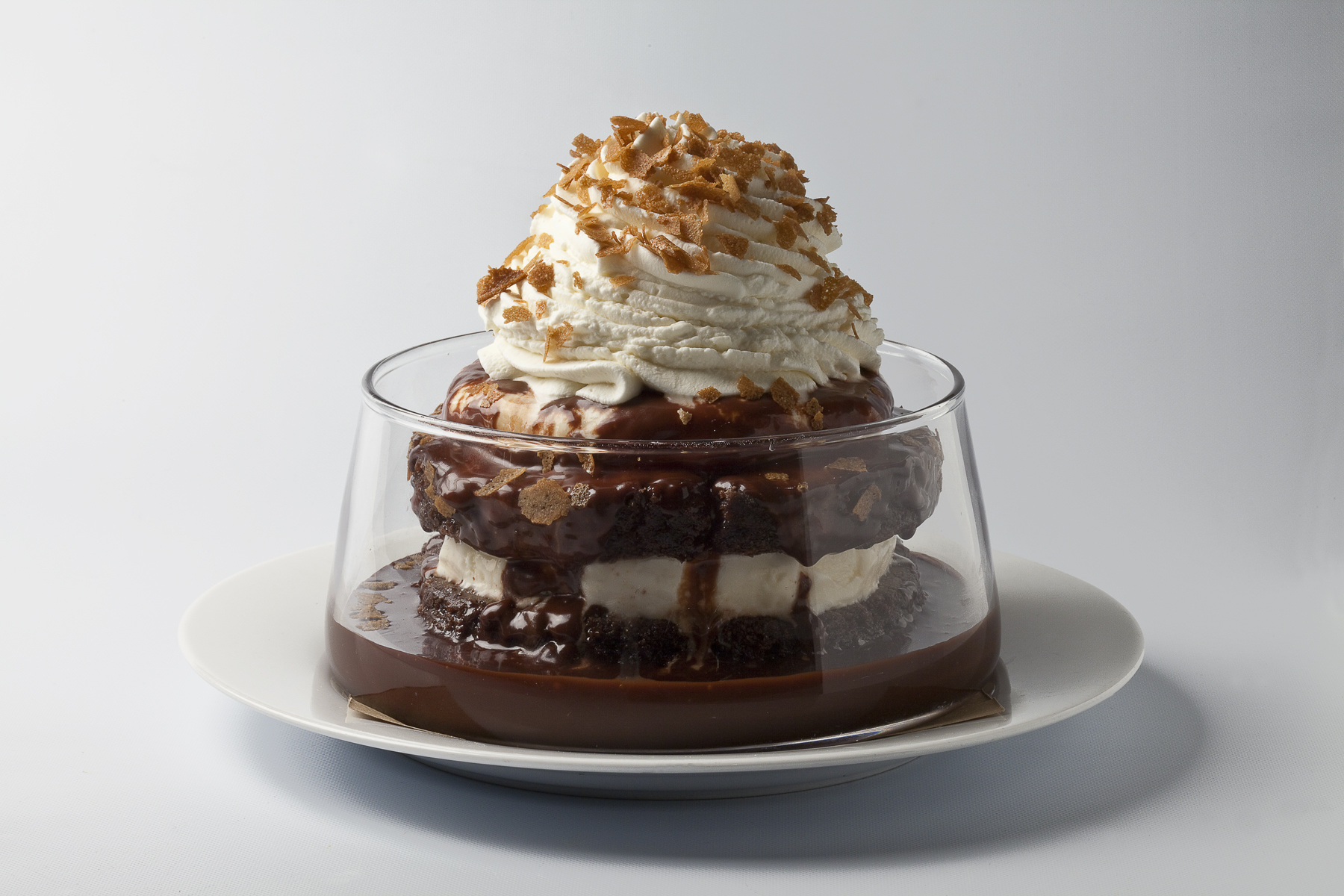 at a Rexall
soda fountain--only at TBar the chocolate and the
ice cream were of higher quality (right). There’s
also a strawberry sundae and a homage to Master
French Chef André Soltner in a reproduction of his
chocolate mousse
laced with rum and coffee ($18). True,
these are expensive desserts, but no one person is
likely to polish one off, so ask for two or three
spoons.
at a Rexall
soda fountain--only at TBar the chocolate and the
ice cream were of higher quality (right). There’s
also a strawberry sundae and a homage to Master
French Chef André Soltner in a reproduction of his
chocolate mousse
laced with rum and coffee ($18). True,
these are expensive desserts, but no one person is
likely to polish one off, so ask for two or three
spoons.
The wine list at TBar has been
carefully built up over the past decade, so there
are some fine bargains among older bottlings.
Tony Fortuna must be very happy
that his clientele is so faithful, but he’s happier
still when a new face comes to TBar to be cosseted
and well fed in a pretty room where people can
actually talk with one another.
Open for lunch Monday through Friday,
brunch Saturday and Sunday, and every night for
dinner.
Email: tony@tbarnyc.com or
manager@tbarnyc.com
❖❖❖
SPANISH WINES
By Brian Freedman
As I walked into the Swann
Lounge at the Four Seasons Hotel Philadelphia, I
saw in the distance several tables spread with
what looked to be nearly two dozen bottles of wine
from Hammeken Cellars. Founder, managing director
and president Nicholas Hammeken and COO and head
winemaker David Tofterup had brought them to town
so that I could experience the range of wines they
are expertly crafting right now. And here they
were, 22 bottles, ranging from Cava to Garnacha to
stunning Tempranillo, all waiting to be sampled
before lunch.
For all the talk of how much
potential the entire country of Spain possesses,
you rarely meet two people who are taking such
successful advantage of it in its seeming
entirety. But that’s exactly what is happening
with Hammeken Cellars, which, since 1996, has
become an important producer of excellent Spanish
wines from 20 different regions around the
country.
Their model is straightforward
but far from easy to achieve: searching Spain for
intriguing terroirs, high quality fruit with the
potential to produce high quality wines crafted in
a more modern style but that also remain
expressive of the un-grafted vines from which they
originate.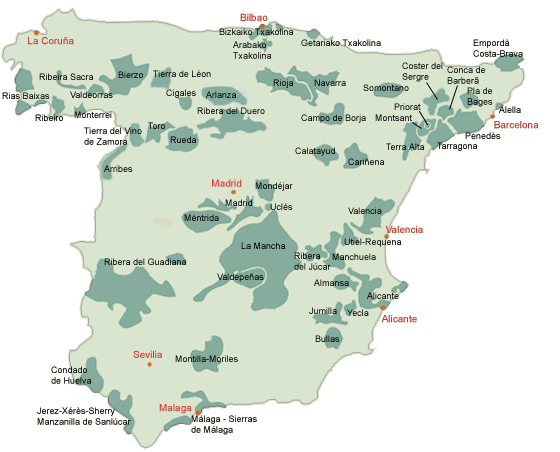 The
resulting wines possess a polish that has allowed
them to appeal to the range of consumers in the 30
countries to which they are exported, and remain
true to their literal and figurative roots.
The
resulting wines possess a polish that has allowed
them to appeal to the range of consumers in the 30
countries to which they are exported, and remain
true to their literal and figurative roots.
In less adept hands, and
without a team with the fastidiousness of the 21
people that comprise Hammeken Cellars (among them
five winemakers), an endeavor like this could
easily have fallen into the trap of cranking out
adequate if not middling wine that failed to
inspire much more than a shrug. But over the
course of the morning we tasted, it became clear
that that was just not the case. These were very
good wines across the range, all of them,
regardless of style, an honest evocation of its
place of origin.
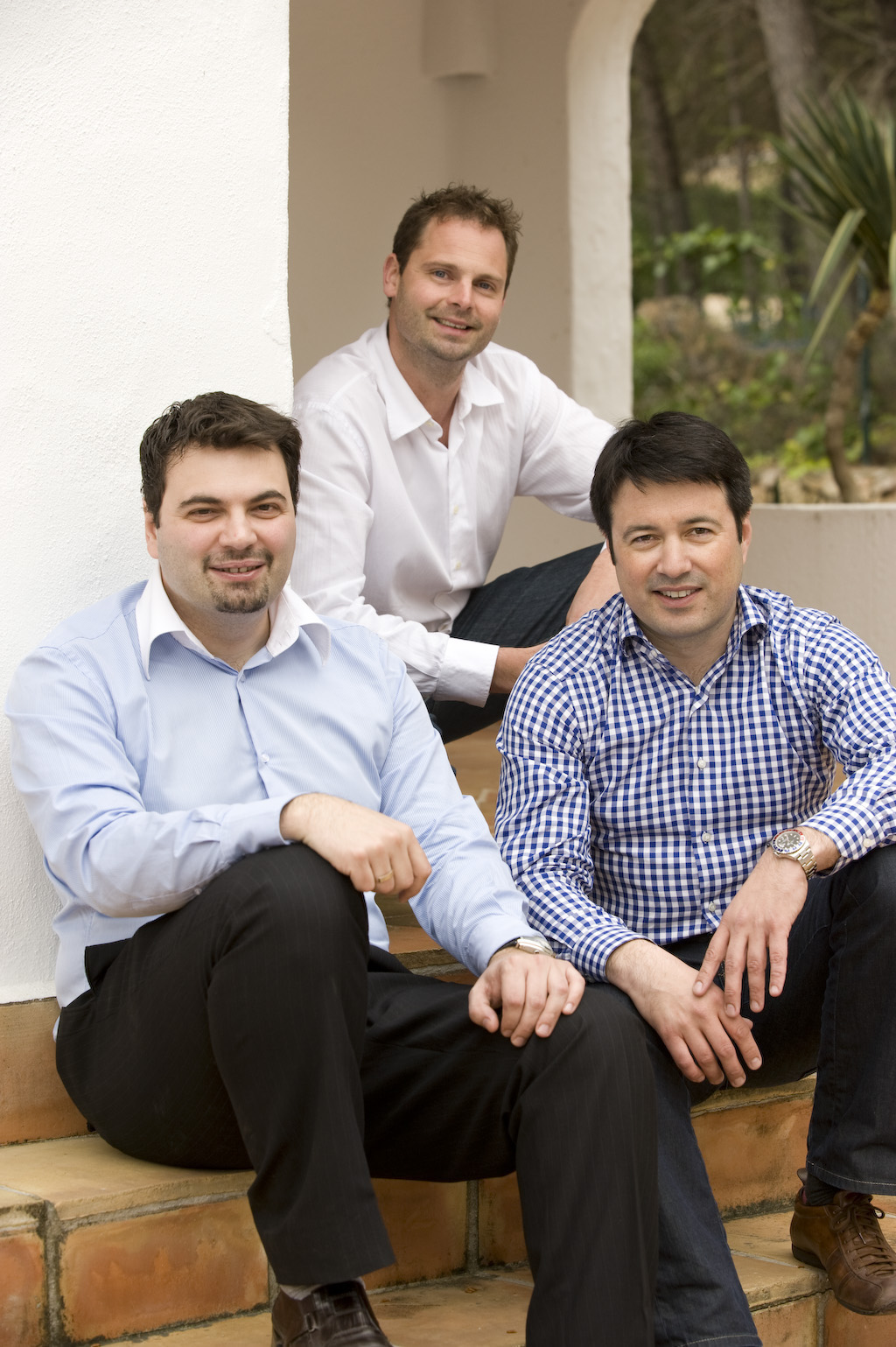 Picos de
Montgo Cava Brut 2011 was scaffolded with
excellent mineral bones and fleshed out with a
creamy texture that carried lemon, lime, and a
nice hint of toasted bread. Viña Altamar
2013, on the other hand, was both elegant
and full of tension: aromas of mineral, lime and
tarragon and a creamier palette with yellow apple
and plum. At $15, it’s a steal.
Picos de
Montgo Cava Brut 2011 was scaffolded with
excellent mineral bones and fleshed out with a
creamy texture that carried lemon, lime, and a
nice hint of toasted bread. Viña Altamar
2013, on the other hand, was both elegant
and full of tension: aromas of mineral, lime and
tarragon and a creamier palette with yellow apple
and plum. At $15, it’s a steal.
Nicholas
Hammeken, David Tofterup and Daniel
Gimenez.
I
thoroughly enjoyed the other wines in the Viña
Altamar line, too. The Ribera del
Duero Tempranillo 2013, from 80-year-old
vines on average, was amazingly concentrated, with
sarsaparilla, purple fruit, and a bit of oak
providing a bass note; and the Mencia 2013
was a bottling that embodied so much of what I
love about Bierzo with its aromatically complex
touches of leather, venison, blackcurrant, tea,
Amarena cherry, and well-balanced acidity. One
rung above is the Barrel
Select Mencia 2012. We tasted a cask sample
one week before it was scheduled to be bottled,
and it was a vivid success.
Sixty-to-eighty-year-old bush vines, hand picked
into 15-kilogram cases, and then, post
fermentation, aged for 9-10 months in French oak,
resulted in a wine of amplified but beautifully
calibrated acidity slicing through a mineral-rich
red with loads of purple berry fruit and notably
sweet tannins. A $26 wine that can age for a
decade, like this one, is well worth stocking up
on.
Hammeken Cellars is making
successful wines throughout Spain, and at a range
of price points--though, aside from two that we
tasted in the $40-$50 range, all were under $25,
and most well below that. This, of course, is one
of the great virtues of Spanish viticulture right
now--fantastic wines are being produced across the
full price spectrum. And an organization like
Hammeken Cellars, which relies on growers around
the country, has the infrastructure to take full
advantage of that.
Radio Boca
is their entry-level label and, at $9, it is a
very good introduction to the wines of Spain. The
2014
Verdejo, for example, 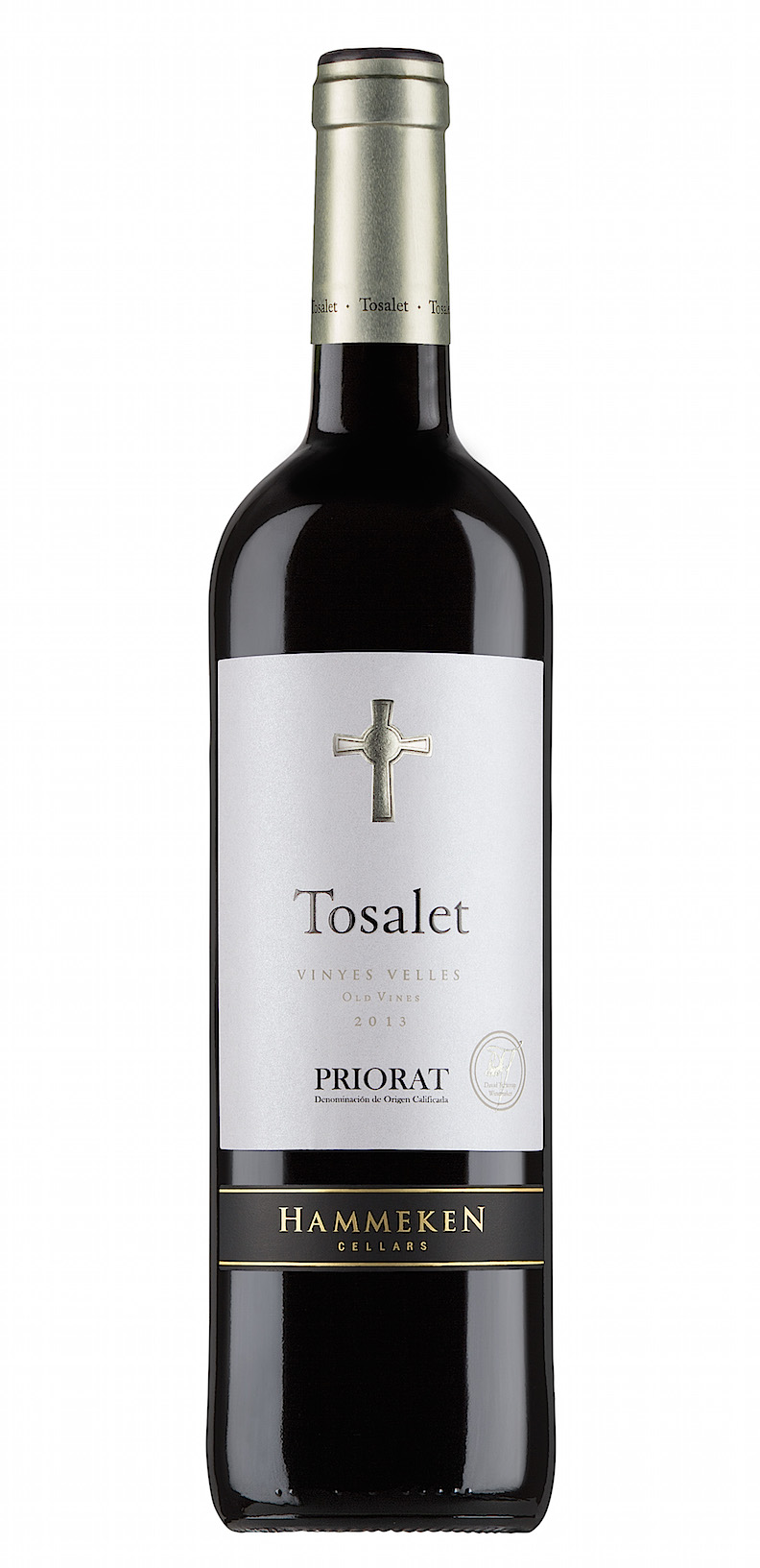 was fresh
and crisp and expressive of candied lemon peel,
with just a bit of residual sugar--enough to make
it a perfect summertime pour while enjoying the
sunshine, but not so much that it dominated the
wine as a whole. The fruit for this one is sourced
from a co-op, which Hammeken and Tofterup
explained to me tends to have the oldest vineyards
and the most tank space and infrastructure for the
Hammeken team to come in and make their wines. The
Tempranillo
2014 also found its footing on the slightly
sweeter-fruited end of the spectrum, but those
notes were joined by flowers, cherries, and cafe
mocha.
was fresh
and crisp and expressive of candied lemon peel,
with just a bit of residual sugar--enough to make
it a perfect summertime pour while enjoying the
sunshine, but not so much that it dominated the
wine as a whole. The fruit for this one is sourced
from a co-op, which Hammeken and Tofterup
explained to me tends to have the oldest vineyards
and the most tank space and infrastructure for the
Hammeken team to come in and make their wines. The
Tempranillo
2014 also found its footing on the slightly
sweeter-fruited end of the spectrum, but those
notes were joined by flowers, cherries, and cafe
mocha.
They are having great success
with Garnacha, famously one of the most important
varieties in the country. The 2013
Flor del Montgo Organic Garnacha, from the
mountainous Bajo Aragon, was savory and powerful,
its 15% alcohol carrying notes of orange peel and
melted black licorice with ease. Picos del
Mongto Old
Vines Garnacha from Cariñena was a $10
steal, its sappy raspberry and red cherry spiced
with Garrigue and lifted with excellent acidity.
It’s a food wine that makes you hungrier the more
you drink.
Montgo
Monastrell 2012 from Alicante was sweetly
fruited on the nose, with plum pudding and cherry
pastry turning to concentrated, acid-zipped
flavors of ripe plum and clove, with dusty tannins
and a very long finish. La Nymphina
Monastrell 2012 from Yecla, on the other
hand, was far more modern on the nose. Aromas of
blackberries, meat and black pepper turned to a
nicely extracted palate of sarsaparilla, black
licorice, and cherry liqueur. And the Pasas Gran
Pasas Monastrell 2012 was a rare example of
a passito Monastrell. Crème de cassis, kirsch, and
chocolate ganache were concentrated and balanced,
and the sweetness was subtle enough to make this
appropriate for dishes before dessert and cheese:
I found myself craving BBQ ribs while sipping
this.
Tosalet
Vinyes Velles 2013 was an excellent
value--$24 for a high quality Priorat is something
worth savoring, especially with its distinct
mineral and slate character framing the blue berry
fruits and licorice. With its sweet tannins and
balance between power and elegance, this is a wine
to enjoy over the next decade and a half.
Aventino
“200 Barrels” Tempranillo 2011, from Ribera
del Duero, was pricier at $40, but complex enough
to justify it. Black cherries, spun sugar, purple
berry fruit, toasted Indian spices, and cocoa
powder kept on evolving and changing in the glass
with air. Rizado
2010 from D.O. Yecla, called out for a
steak. The 70% new oak didn’t overwhelm, but the
wine would definitely benefit from the fat and
protein of a good rib eye. And while it promises
to continue evolving for another decade-plus, the
cherries, tar, meat, and remarkable concentration
make it approachable now, especially, perhaps,
with a stint in the decanter.
And while we tasted less than
half of the entire Hammeken Cellars line-up--they
produce more than 50 wines in total, with some
being made in South America and Chile--the success
they are having was abundantly clear. They’re more
than worth seeking out. All the promise of the
spread of bottles that greeted me that morning was
more than borne out, and deliciously so.
❖❖❖
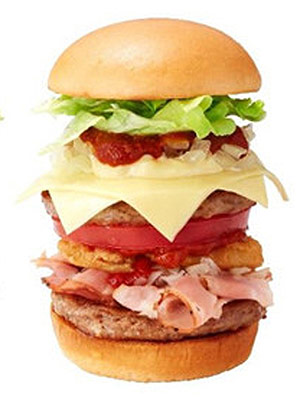
WATCH FOR THE MOVIE! "GODZILLA VS THE MOS
BURGER"
MOS
Burger,
the biggest fast-food chain in Japan after
McDonald's, is commemorating the opening of a
location in the 1,093-foot Tokyo Tower's food court
with the Tokyo Tower Burger, consisting of 14 layers
($7) that includes Lettuce, Hot chili
sauce, Chopped onion, Mayo, Patty,
tomato slice, Hot chili sauce, Onion
ring, Ketchup, chopped onion,
Pastrami bacon, another patty plus bun.

Actress and model Suki Waterhouse (right) contends her hair owes its volume to actually rinsing with Coca-Cola. "I rinse my hair with Coca-Cola sometimes," said the 23-year-old model and Insurgent actress. "I don't like my hair when it's washed — it's fine and limp — but Coca-Cola makes it tousled, like I've gone through the Amazon or something.”
Any of John Mariani's books below may be ordered from amazon.com.
 I'm proud and happy to announce that my
new book, The Hound
in Heaven (21st Century Lion Books), has just
been published through Amazon and Kindle.
I'm proud and happy to announce that my
new book, The Hound
in Heaven (21st Century Lion Books), has just
been published through Amazon and Kindle. It is a novella, and for anyone who loves dogs, Christmas, romance, inspiration, even the supernatural, I hope you'll find this to be a treasured favorite. The story concerns how, after a New England teacher, his wife and their two daughters adopt a stray puppy found in their barn in northern Maine, their lives seem full of promise. But when tragedy strikes, their wonderful dog Lazarus and the spirit of Christmas are the only things that may bring back his master back from the edge of despair.
WATCH THE VIDEO!
“What a huge surprise turn this story took! I was completely stunned! I truly enjoyed this book and its message.” – Actress Ali MacGraw
“He had me at Page One. The amount of heart, human insight, soul searching, and deft literary strength that John Mariani pours into this airtight novella is vertigo-inducing. Perhaps ‘wow’ would be the best comment.” – James Dalessandro, author of Bohemian Heart and 1906.
“John Mariani’s Hound in Heaven starts with a well-painted portrayal of an American family, along with the requisite dog. A surprise event flips the action of the novel and captures us for a voyage leading to a hopeful and heart-warming message. A page turning, one sitting read, it’s the perfect antidote for the winter and promotion of holiday celebration.” – Ann Pearlman, author of The Christmas Cookie Club and A Gift for my Sister.
“John Mariani’s concise, achingly beautiful novella pulls a literary rabbit out of a hat – a mash-up of the cosmic and the intimate, the tragic and the heart-warming – a Christmas tale for all ages, and all faiths. Read it to your children, read it to yourself… but read it. Early and often. Highly recommended.” – Jay Bonansinga, New York Times bestselling author of Pinkerton’s War, The Sinking of The Eastland, and The Walking Dead: The Road To Woodbury.
“Amazing things happen when you open your heart to an animal. The Hound in Heaven delivers a powerful story of healing that is forged in the spiritual relationship between a man and his best friend. The book brings a message of hope that can enrich our images of family, love, and loss.” – Dr. Barbara Royal, author of The Royal Treatment.
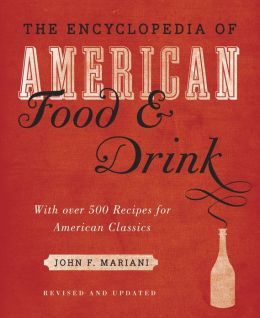 |
The Encyclopedia of American Food and Drink by John F. Mariani (Bloomsbury USA, $35) Modesty forbids me to praise my own new book, but let me proudly say that it is an extensive revision of the 4th edition that appeared more than a decade ago, before locavores, molecular cuisine, modernist cuisine, the Food Network and so much more, now included. Word origins have been completely updated, as have per capita consumption and production stats. Most important, for the first time since publication in the 1980s, the book includes more than 100 biographies of Americans who have changed the way we cook, eat and drink -- from Fannie Farmer and Julia Child to Robert Mondavi and Thomas Keller. "This book is amazing! It has entries for everything from `abalone' to `zwieback,' plus more than 500 recipes for classic American dishes and drinks."--Devra First, The Boston Globe. "Much needed in any kitchen library."--Bon Appetit. |
"Eating Italian will never be the same after reading John Mariani's entertaining and savory gastronomical history of the cuisine of Italy and how it won over appetites worldwide. . . . This book is such a tasteful narrative that it will literally make you hungry for Italian food and arouse your appetite for gastronomical history."--Don Oldenburg, USA Today. "Italian
restaurants--some good, some glitzy--far
outnumber their French rivals. Many of
these establishments are zestfully described
in How Italian Food Conquered the World, an
entertaining and fact-filled chronicle by
food-and-wine correspondent John F.
Mariani."--Aram Bakshian Jr., Wall Street
Journal.
"Equal parts
history, sociology, gastronomy, and just
plain fun, How Italian Food Conquered the
World tells the captivating and delicious
story of the (let's face it) everybody's
favorite cuisine with clarity, verve and
more than one surprise."--Colman Andrews,
editorial director of The Daily
Meal.com. "A fantastic and fascinating
read, covering everything from the influence
of Venice's spice trade to the impact of
Italian immigrants in America and the
evolution of alta cucina. This book will
serve as a terrific resource to anyone
interested in the real story of Italian
food."--Mary Ann Esposito, host of PBS-TV's
Ciao
Italia. "John Mariani has written the
definitive history of how Italians won their
way into our hearts, minds, and
stomachs. It's a story of pleasure over
pomp and taste over technique."--Danny Meyer,
owner of NYC restaurants Union Square
Cafe, The Modern, and Maialino.
|
 |
 |
 |
 |
 |
 |
 |
 |
 Everett Potter's Travel Report:
Everett Potter's Travel Report: 
 Eating Las
Vegas is the new on-line site for
Virtual Gourmet contributor John A. Curtas.,
who since 1995 has been commenting on the
Las Vegas food scene and reviewing
restaurants for Nevada Public Radio.
He is also the restaurant critic for KLAS
TV, Channel 8 in Las Vegas, and his past
reviews can be accessed at KNPR.org.
Click on the logo below to go directly to
his site.
Eating Las
Vegas is the new on-line site for
Virtual Gourmet contributor John A. Curtas.,
who since 1995 has been commenting on the
Las Vegas food scene and reviewing
restaurants for Nevada Public Radio.
He is also the restaurant critic for KLAS
TV, Channel 8 in Las Vegas, and his past
reviews can be accessed at KNPR.org.
Click on the logo below to go directly to
his site.

Tennis Resorts Online: A Critical Guide to the World's Best Tennis Resorts and Tennis Camps, published by ROGER COX, who has spent more than two decades writing about tennis travel, including a 17-year stretch for Tennis magazine. He has also written for Arthur Frommer's Budget Travel, New York Magazine, Travel & Leisure, Esquire, Money, USTA Magazine, Men's Journal, and The Robb Report. He has authored two books-The World's Best Tennis Vacations (Stephen Greene Press/Viking Penguin, 1990) and The Best Places to Stay in the Rockies (Houghton Mifflin, 1992 & 1994), and the Melbourne (Australia) chapter to the Wall Street Journal Business Guide to Cities of the Pacific Rim (Fodor's Travel Guides, 1991).


MARIANI'S VIRTUAL GOURMET
NEWSLETTER is published weekly. Editor/Publisher: John
Mariani.
Editor: Walter Bagley. Contributing Writers: Christopher Mariani,
Robert Mariani, Misha
Mariani,
John A. Curtas, Edward Brivio, Mort Hochstein,
Andrew Chalk, Dotty Griffith and Brian Freedman. Contributing
Photographers: Galina Dargery, Bobby
Pirillo. Technical Advisor: Gerry McLoughlin.
To un-subscribe from this newsletter,click here.
© copyright John Mariani 2015

